Popular varieties of achimenes

The very name of the indoor flower "achimenes" ("those who are afraid of the cold") suggests that this plant is from warm countries. His homeland is Central and South America, where Achimenes bloom all year round. In indoor floriculture, they are appreciated for the variety and brightness of the color palette that can decorate any interior.
Peculiarities
Akhimenes belongs to the genus of flowering plants from the Gesneriev family. It is a perennial rhizome herb that blooms with beautiful multi-colored inflorescences. This flower is considered a relative of Gloxinia and Violet. It is characterized by brightness and abundance of flowering.
The root system is a rhizome rhizome, covered with scales and very reminiscent of birch catkins or spruce cones. The flower has weak stems and weakly branching shoots, covered with a shell of dark green color, sometimes with a reddish tint. The stems can grow vertically or fall down and spread.
Ahimenes is distinguished by the duration of flowering - it begins in May and ends only in October. Inflorescences with 5 petals can be single or paired and are characterized by a variety of colors and shades.
The outer surface of the leaves is smooth and shiny, veins stand out well on it. Their color can be deep green, pinkish and even crimson. The inner side is slightly pubescent. The leaves are oblong, the edges are wavy, finely toothed.
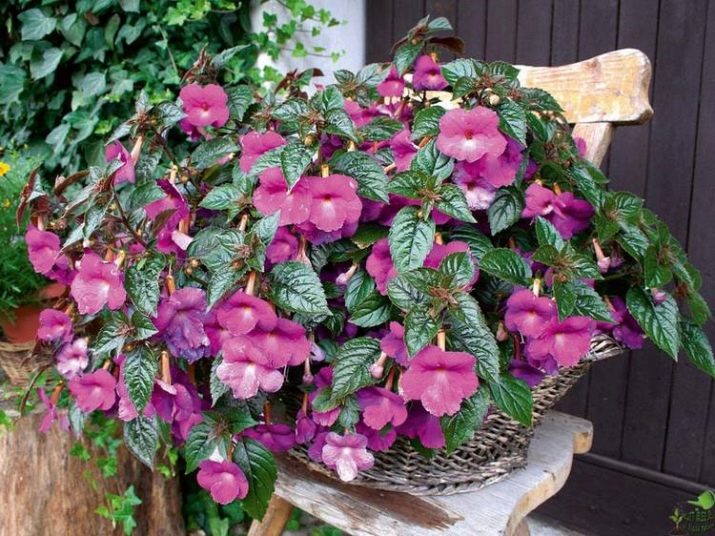
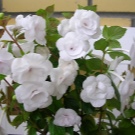
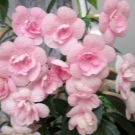
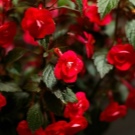

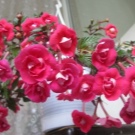
The genus of this flower is distinguished by many species (about 26), varieties and bred hybrids. The main types of Achimenes are subdivided according to such characteristic features.
- Growth type of stem and shoots. Ahimenes are divided into growing straight, semi-ampelous and ampelous. In upright achimenes, the stem grows vertically, and the lateral shoots grow to the sides, forming a bush. Ampel plant species have a flexible stem, which is lowered down, and creeping shoots. In semi-ampelous Achimenes, curly shoots require a direction of growth.
- Plant size. The height of the flower can fluctuate between 25-50 cm.
- Type of inflorescences. Flowers are simple with smooth petals, semi-double or fully double.
- The size of the inflorescences. Achimenes flowers can be small (2.5-3 cm), medium (3-4.5 cm) and large - up to 6 cm in diameter.
- Color coloration of inflorescences. The color scheme is represented by almost the entire palette of shades: white, various shades of red - from pink to burgundy, purple and blue, yellow and orange. By color, two species are especially distinguished - candida (white) and coccinea (bright red or purple-red shades).
- The shape of the buds. They are round, elongated, or bell-shaped.
A special place in the species diversity is occupied by the Mexican species and the Achimenes of Erinberg. A distinctive feature of the first is the color of its leaves. Outside, they have a rich green color, and the inner surface is beetroot. The color of the inflorescences is lilac.
View Ehrenberg is atypical for the genus Achimenes. Lettuce leaves are egg-shaped with a very thick pile (like cotton wool) on the inner surface. Bell-shaped inflorescences are painted in lavender tones.
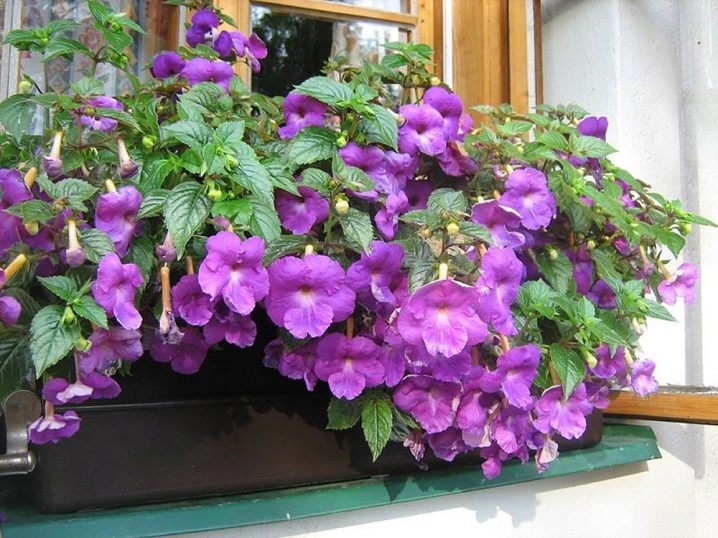
Varietal variety
In addition to the natural species of this extraordinary flower, there are still a huge number of varieties bred by breeders.They used wild varieties of Achimenea, and as a result of hybridization, numerous beautiful varieties appeared, characterized by large inflorescences, extraordinary appearance and even with colors that are not in natural growth.
Achimenes of such varieties are considered the most famous and beloved among flower growers.
"Yellow English Rose". A large number of varieties with a flower resembling a rose were created by the famous Romanian breeder Serge Saliba. This variety of achimenes was first put up for evaluation by flower growers in 2012. It belongs to the type of terry achimenes.
Large (up to 6 cm) lush double flowers have a beautiful pure pale yellow shade and edges with a corrugated and fringed line. To preserve this color in the culture, it is recommended to keep it in places with diffused lighting. When kept in cool conditions, the inflorescence takes on a creamy or soft coral shade. During abundant flowering, the bush requires support.
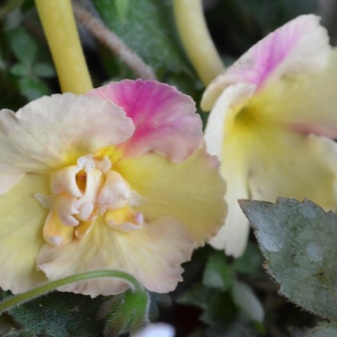

"Double Pink Rose". This variety of achimenes is characterized by a long, splendid and abundant flowering. The upright shoots, covered with narrow leaves, branch well and form a dense but neat bush. It blooms with lush double inflorescences of a pale pinkish tone. The flowers are quite large.

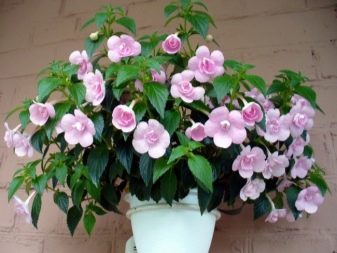
- "Made in Heaven"... It is also a terry look. Its spectacular large inflorescences of a transparent blue color have an elusive lavender shade. It blooms for a long time and profusely. Leaves with serrated edges are light green in color. The stem with straight shoots grows vertically. Differs in unpretentiousness, undemanding to the conditions of detention.
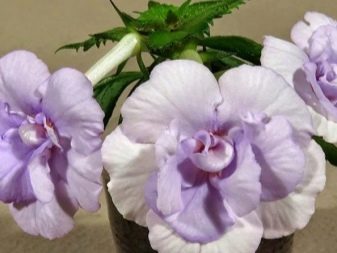
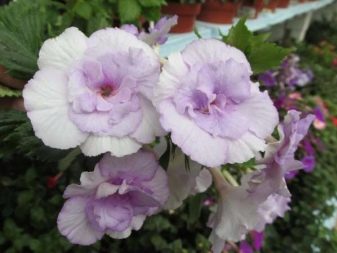
"Giselle". An unpretentious variety with abundant flowering. Shoots and trunk are erect. "Giselle" amazes with the beauty of its double, rather large flowers with a coral-pink color. Sometimes the petals take on a peach or yellowish tint. Inflorescences can be regular or uneven, as if ruffled, in shape.

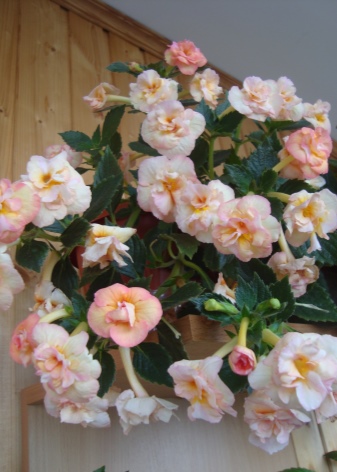
- Peach Blossom. Ahimenes ampelous type. The plant is rather short, capable of reaching a height of 25 cm. It blooms profusely, up to 8 buds can be tied on one branch. The leaves have an elongated shape. Their outer surface is deep green, and the inner one has a burgundy tint.
Flowers of medium size (about 3-4 cm) stand out brightly against the rich green background of the foliage. The flower petals are painted in delicate pastel pink tones with a lilac tint, and the middle is purple with a pale yellow speck. Ahimenez is not capricious in leaving.
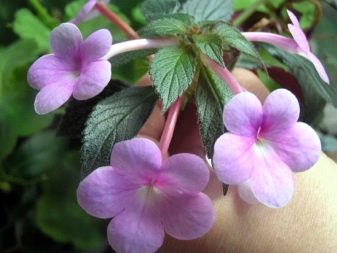
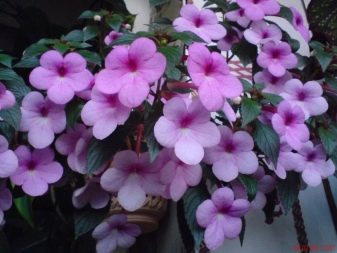
"Hot Spot"... The processes are upright. The bush has a neat compact appearance. The twigs are covered with serrated leaves of a light green color. The variety has medium-sized double flowers of intense yellow color with chaotic cherry-red blurred spots, which become more and more saturated during the flowering process.
The plant feels good only with sufficiently intense lighting, good aeration and demanding heat. At low temperatures, spots on the petals disappear.
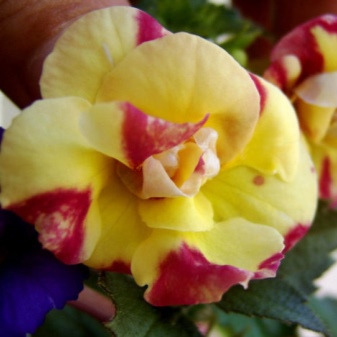
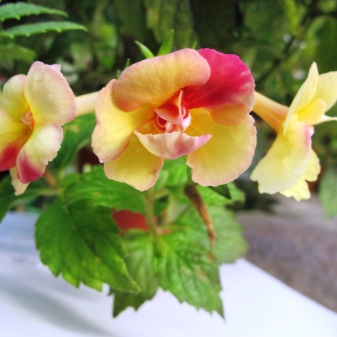
- Tropical Dusk. The variety forms a low bush with upright processes. Small green leaves have a finely serrated edge. Terry flowers have an average size (up to 3.5 cm). The plant is distinguished by its brightness and unique combination of tones of a wide range of colors. The juicy purple tones of the petals near the middle of the inflorescence suddenly acquire orange and lilac highlights. This color makes the flower seem to glow from the inside.
The advantages of the variety, in addition to the unique color, are also considered to be stable terry, full disclosure of its buds and abundant flowering.
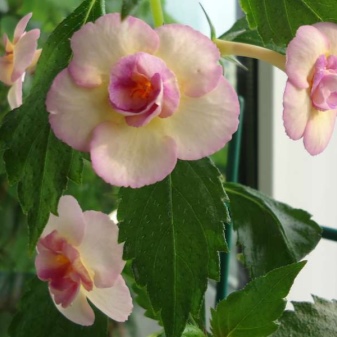
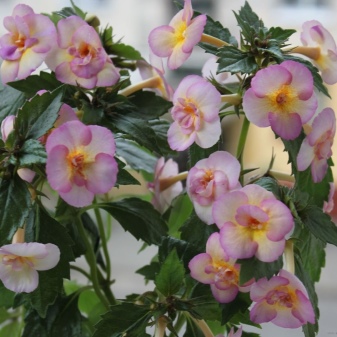
- "Cote d Ivoire"... The variety from the collection of S. Salib belongs to the erect species of Achimenes, forming a medium-sized bush. Semi-double flowers look beautiful on green leaves.Its flowers are painted in pale yellow (ivory) colors, smoothly turning into rich yellow, and the pharynx has brown specks with a reddish tint.
The wavy ends of the petals are decorated with a delicate lilac border. The petals are capable of changing color when the temperature changes: from pale to bright lemon color, and at temperatures above +30 they acquire a lilac color.
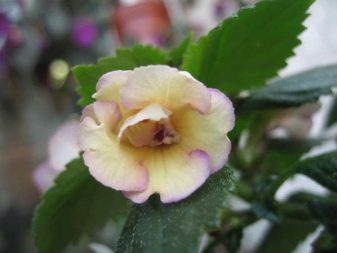
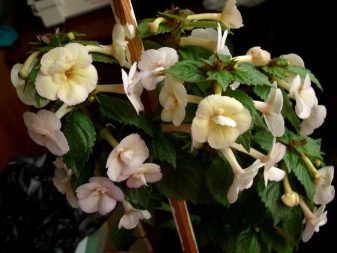
"Stan`s Delight" refers to an erect species, and even one process forms a densely branched bush with a brown stem. The foliage is deep green in color, its inner surface is painted in burgundy tones. Ahimenes has lush, densely double flowers of small size (about 2.5 cm) with an uneven edge of the petals.
The dazzling bright crimson-red or scarlet color of inflorescences is striking. Its peculiarity is that the buds open slowly, slowly, but this is compensated by the duration of flowering. During the period of active flowering, some inflorescences can open completely, and some buds remain dense, not fully blooming.
The plant is undemanding to conditions of maintenance and care.


- Ambroise Verschaffelt. This variety was obtained after hybridization of the natural large-flowered Achimenes with the Rinzi variety. The plant has strong, powerful and tough shoots, which are directed upward at the beginning of growth, and then droop over time. Large flowers have petals with well-defined edges.
The variety is distinguished by the originality of color - thin purple veins are clearly visible on the white petals, forming an openwork mesh, and the core is covered with dots of the same color. Therefore, this achimenes is also called chintz.
This color makes the variety unique and adds aesthetic and decorative appeal to it. With age, the flower takes on the shape of a shrub, covered with a cascade of inflorescences during the flowering period.


"Alter Ego" or "Second Me"... Belongs to the ampelous species, forms a tall and branched bush with a burgundy stem. The variety surprises with the size of its inflorescences, reaching 7 cm, as well as the color of the petals of double flowers, which can take on various shades - from pale blue to deep blue in accordance with the lighting, which is reflected in its name.
The plant forms so many inflorescences that the shoots cannot support their weight, they bend and droop. Therefore, during the period of active flowering, it is required to prop up the branches.

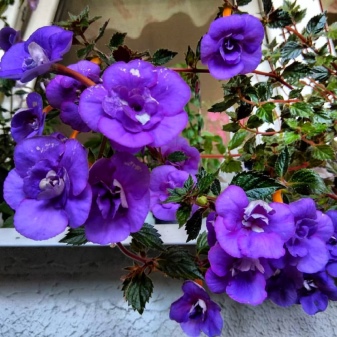
"Yellow Fever". This is a flower with ampelous shoots. Flowers of medium size can be either double or half double. The bright yellow color along the edges of the petals gradually becomes lighter, and sometimes acquires pinkish tints. The color of the inflorescence is stable and consistent, and the flowering is very abundant. Undemanding to the conditions of detention.

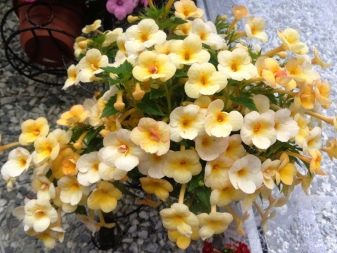
- "Last Dawn"... A variety of ampelous species, capable of branching well, forming a compact, small bush. Shiny leaves are light green in color. Terry inflorescences of large size have extravagant colors - from yellow to all sorts of shades of purple. The wavy corrugated edges of the petals are dotted with small dark dots.
"Last Dawn" can bloom not only double, but also non-double flowers. Such inflorescences have an original spotted core. Flowers on one plant can be of different colors. The reason for this phenomenon lies in the chimeric property of this variety, which is expressed in the ability to reflect changed conditions of detention (temperature, lighting, climate) in color changes. It blooms for a long time and abundantly.
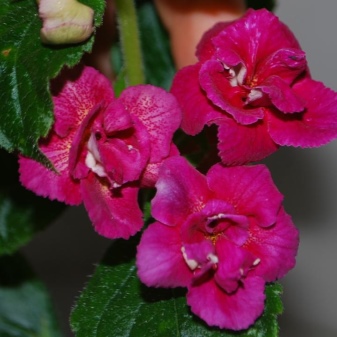

- Venice... A miniature compact bush with short, straight shoots, covered with small light green leaves with small serrations. Delicate small flowers (about 2.5 cm) can be semi-double or fully double.
The middle of the bright lilac-violet petals is yellow with a wide white halo.Simple non-double flowers can also bloom during the flowering period. The variety is undemanding to the conditions of maintenance and care and even tolerates direct sunlight.

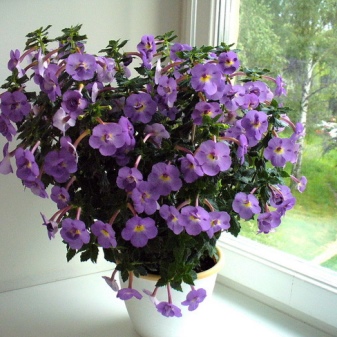
- "Peach Orchard" - "Peach Orchard"... The variety belongs to the ampelous type of Achimenes. The neat bush has medium-sized light green serrate leaves with a sharp tip. Medium inflorescences are both double and semi-double. The color of the petals with its delicate matte yellow and light orange shades, like a peach, emphasizes the grace of the flowers, which look spectacular against the light green background of the foliage.
On the peach color, cherry-tone stains stand out brightly, and along the very edge of the petals there is a rim of a rich pink color. With bright diffused light and good care, the buds open better and the inflorescences become larger. Ahimenes of this variety pleases with long and abundant flowering.
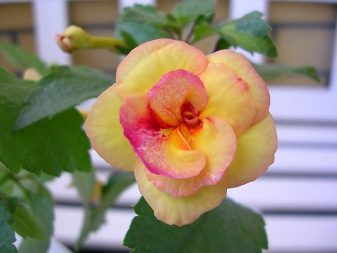
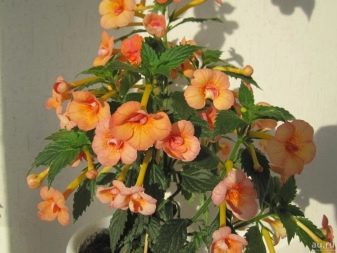
Care Tips
When growing these wonderful flowers, agricultural technology is of great importance. Ahimenes love good and consistent grooming, the rules of which are not that complicated. In order for the flower to please with abundant flowering, it is recommended to adhere to such conditions of detention.
Lighting and temperature control
Unlike other indoor plants, achimenes is not recommended to be placed in places on the south side. Intense bright sunlight is permissible only before and during the budding period and subject to shading with tulle curtains. During flowering, such a bright light is contraindicated. The flowering plant should be placed some distance from a window or on a windowsill in the east or west.
But if the shoots and stem begin to stretch out, then the plant does not have enough lighting. In this case, it must be placed in a brighter place.
It is also important to know that Achimenes with dark leaves need much more sunlight than specimens with light green and variegated foliage.
The temperature regime also depends on the cycles of plant development: during the dormant period, the temperature should not exceed +15.18 degrees, and during flowering it should be within + 22.24 degrees. But a sharp transition from a warm content to a cooler one should not be allowed. This should be done gradually, gradually lowering the temperature. So the flower adapts to the coolness, gets stronger and can safely overwinter.
For this purpose, it is placed in a room less warm than living rooms (balcony, veranda, loggia).
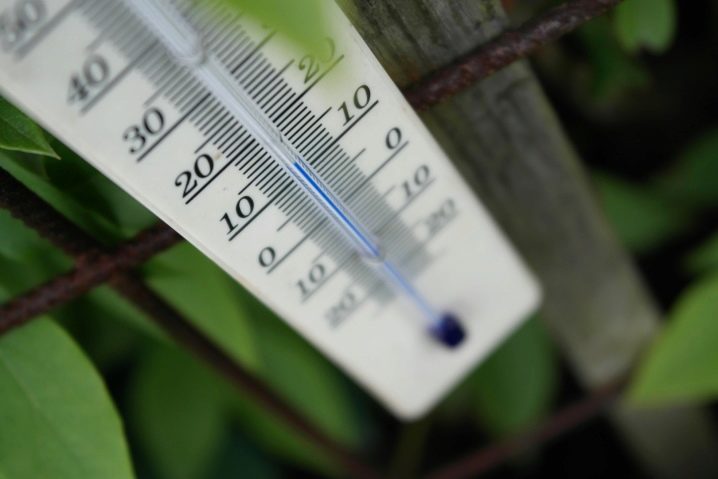
Watering and humidity
Being a tropical plant, indoor achimenes requires high air humidity - up to 60%. It is impossible to spray the bushes to increase the humidity, as stains appear on the leaves from the water. You can increase the humidity in the following ways:
- use special humidifier devices;
- do spraying near the plant;
- place pebbles or special moss (sphagnum) in the pallet and moisten them constantly.
You also need to water the plant according to the rules:
- you can only use settled water, which is slightly warmer (by 2-3 degrees) than the air in the room;
- you can not pour water on top of the crown and inflorescences, you only need to moisten the soil under the plant;
- excess water from the sump must be drained after each watering;
- watering is stopped during the winter dormancy of achimenes.


Soil composition and top dressing
In flower shops you can buy ready-made soil, special for Achimenes. Potting mix can also be made at home. This plant loves light, slightly acidic soil. The composition of the substrate should include the following components: 2 parts of sheet soil, 1 part of peat and 1 part of sand. When planting on the bottom of the container, a drain must be placed.
Only flowering bushes need fertilization. Top dressing is applied with an interval of 1 time in 10-14 days. It is recommended to use complex fertilizers. The first feeding can be applied only 1.5 months after the end of the dormant period.
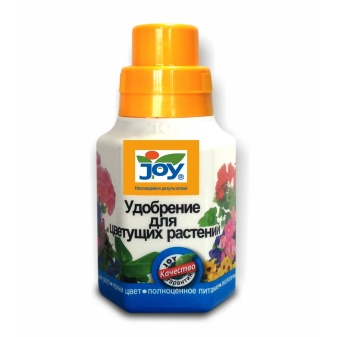

Pruning
Pruning or pinching is a prerequisite for growing Achimenes. Without it, you cannot form a beautiful bush of the correct shape. The plant will not branch and form a large number of buds. You need to pinch young shoots at the level of the second or third leaf. Although pruning delays bud opening a little, but as a result, dormant buds receive an impetus for rapid development.
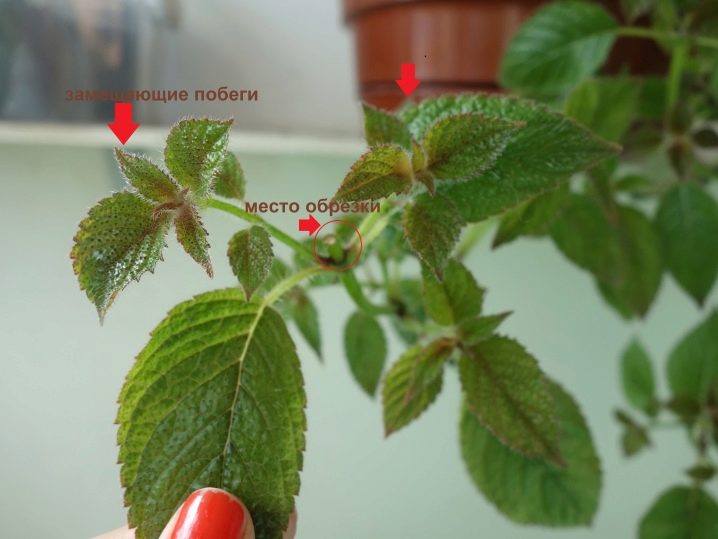
Transfer
A bush can be transplanted only after the plant wakes up. The bush is pulled out of the bowl, the soil is carefully removed and the tubers - rhizomes are released. Old rhizomes are removed, and young ones must be transplanted for subsequent cultivation. Rhizomes should only be healthy, without signs of mold.
If the tubers are slightly affected by mold, they are treated with a fungicide solution, and if they are extensive, they are thrown away.
The transplant is carried out in this order: a third of the bowl is filled with drainage, then a layer of soil, and on top of a small (about 1.5 cm) layer of sand. Rhizomes are placed on the sand, and then covered with the rest of the earth.
It is advisable to use wide, but shallow containers. It is not recommended to plant achimenes of various varieties in one bowl, since each variety or species has its own characteristics, and more active and intensively developing species restrain and weaken those specimens whose development begins later.
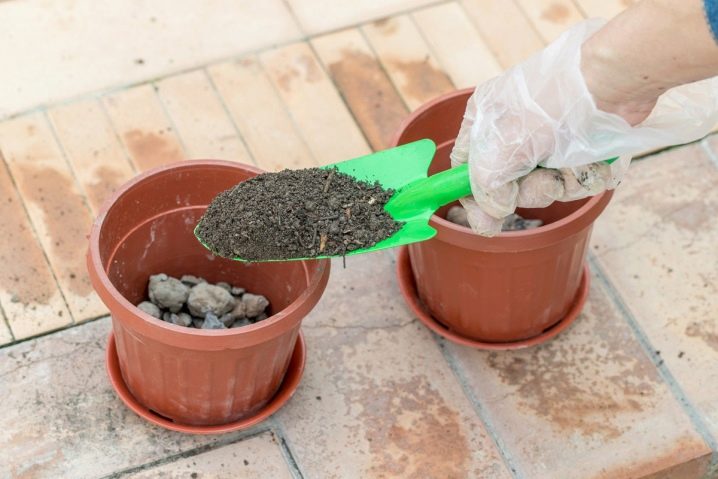
Resting care
In the life of flowers, a period begins when the terrestrial part of achimenes dies, and the root system continues to live. At this time, tubers are stocked with nutrients and develop.
The dormant state usually begins in the last days of October and lasts about 2.5 months.
Dry stems need to be cut off, and the bowl should be placed in a cool and dark place.
It is possible not to water the soil, but not frequent and light moistening of the soil will be beneficial. It is necessary to ensure that the bush does not wake up ahead of time... In this case, it must be placed in a lighter room, increasing its exposure to the light, and allowing the plant to develop. But usually the bush wakes up in February. The tubers are taken out and checked again, and then transplanted into a bowl, replacing the old soil with fresh one.
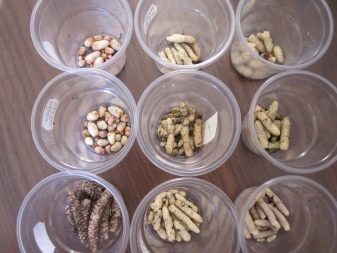
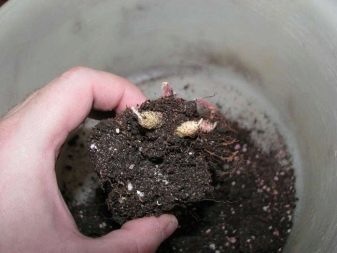
Sometimes, with improper care, Achimenes have some problems.
If brown buds appear on the bush, then most often the plant reacts in this way to too high a temperature of the content. When watering with cool water, spots may appear on the foliage, and if there is an excess of fertilizer, the crop sheds its leaves.
But similar manifestations can also occur when damaged by harmful insects: aphids, spider mites, mealybugs, thrips. If they are found, the flower must be treated with insecticides, such as "Aktara", "Fitoverm".
If the foliage becomes inelastic and soft or rot appears on it, then root rot disease may have arisen. It is the result of improper watering. With ring spot on the leaf blades, spots appear at first light in color, which then turn brown. In this case, the use of fungicides is recommended.
The efforts spent on leaving will not be in vain - Achimenes will thank you with a beautiful, bright and lush flowering, which will delight the eye for a long time.
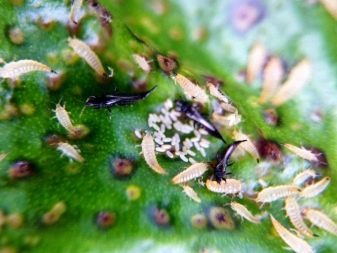
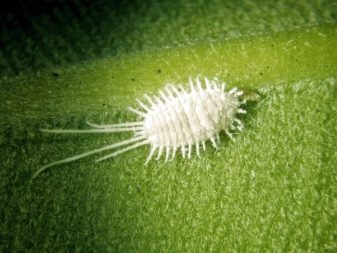
For the secrets of successful Achimenes care, see below.

































































































The comment was sent successfully.